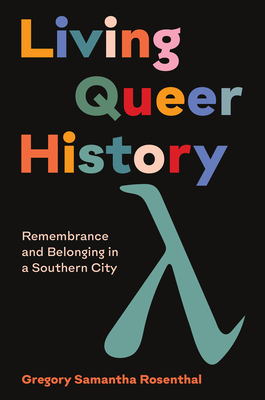In my final semester at Appalachian State I wrote a review of Gregory Samantha Rosenthal’s Living Queer History, a nonfiction work describing Dr. Rosenthal’s work to co-organize an ongoing queer history collection and curation project in Roanoke, VA. I absolutely loved this book and Dr. Rosenthal’s dedication both to shining a light on a quickly-forgotten set of communities and experiences and her frankness in talking about both their successes and places where their work needed improvement. This is one part academic work, one part handbook for others to follow, and one part personal memoir of self-discovery. I strongly recommend it.
Living Queer History: Remembrance and Belonging in a Southern City
By Gregory Samantha Rosenthal (Chapel Hill: The University of North Carolina Press, 2021)
$29.95, paper. ISBN 978-1-4696-6580-1, 288 pp.
From the beginning, Gregory Samantha Rosenthal states the central theme of Living Queer History: “the presence of the past is always with us” (4). She then demonstrates this through meticulous research, frank honesty, a refreshingly open discussion of missteps, and her very personal story of coming out as a result of the work she and others do for the Southwest Virginia LGBTQ+ History Project. Through anecdotes, oral history excerpts, and detailed discussion of methodologies, Rosenthal proves the reality that history is as much an element of the future as it is a documentation of our past.
Rosenthal opens with the personal and professional path that led her to a history professorship in a small Southern city on the edge of Appalachia. Upon getting involved in a local organization promoting diversity in the city, Rosenthal and others realized there were no dedicated LGBTQIA+ organizations and no strong sense of the queer history of a city that has always been home to many queer people. From that, the Southwest Virginia LGBTQ+ History Project was born.
Rosenthal details the combined conscious choices and happenstance that set this project apart from other community-based research efforts. For instance, the group began with no grant funding, no formal institutional support, and no structure. Rather than start with an org chart, a mission statement, and a grant, the group asks, what research might benefit Roanoke’s queer population? Then, piecemeal, they put together the resources to support as many of those goals as possible–funding, a permanent archive, a means to process and exhibit oral histories–and adjust as the project progresses.
One of the many dangers of an “objective” approach to research is becoming yet another extraction industry. A less engaged, less considerate collection effort might, for instance, have focused only on cisgender gay men, the worst of the HIV/AIDS pandemic, or criminalization of LGBTQIA+ people and never on their joy. A lesser project might have tucked their work away where no one could access them. As Rosenthal says, “In remembering a past that was bibliographic, archival, or even literary, queer historians could only see some of the past—just what was written down, and often written down by others” (63). Such a project would have worsened the marginalization of those they overlooked and done nothing to help the people who need this history most.
Instead, Rosenthal and her co-researchers adhere to the philosophy “that it is imperative that so-called experts […] understand that their authority […] is shared with that of experients” (72). They welcome anyone from the community who attends a meeting, and anyone attending a meeting gets to vote. With no formal leadership structure they are each free to rise to the occasion–or falter in their attempt. Rosenthal’s experience as an Occupy Wall Street organizer and her research and instructional expertise combine to maintain academic rigor and ethical practices while allowing the group’s work to be directed by those to whom it matters most.
Throughout, the group welcomes feedback and criticism as an important mechanism for realizing factors of which a given individual might be unaware. The openness of the organization does not prevent–and sometimes leads to–major mistakes. The group’s first iteration of their walking tour focused solely on historical bars catering to cisgender gay men, most of which were functionally segregated by race and gender. Their first narrators are all white. Efforts to include the histories of people of color result sometimes in hurt feelings, ostracization, and emotional harm. In one interview, Rosenthal realizes an older Black gay narrator may be softening his story to make the narrator’s white husband more comfortable. In another, a narrator names participants in illegal activities and puts the project in the position of destroying much of a powerful recording or risking legal consequences. Some narrators make students feel unsafe, and others resent speaking with youth they do not understand. The project reveals deep divisions between generations. As Rosenthal puts it, “Our community is splintered by age, race, gender, and sexuality, and subgroups tell their own stories about the queer past: what happened, who mattered, and what it was like back then” (66).
The same openness that allows errors, however, enables the organization to ask why they occur and how to avoid them. Rosenthal documents not just the histories collected by the group’s research but how and why they adjust their methods and, importantly, whether those adjustments result in positive change. This book is more than a retelling or interpretation of the histories recorded, more than a personal narrative, and more than a discussion of the mechanics of founding and conducting a successful and ongoing oral history project in Appalachia. It’s an important demonstration of the power–and the risks–of taking academic work beyond the walls of the academy and putting its tools directly into the hands of the people who might otherwise be its subjects instead of its participants.
As a narrator in a queer history project at UNC Chapel Hill, I found this book invigorating and inspiring. It made me wonder, is anyone documenting the LGBTQIA+ history of my home, Durham, NC, a majority- minority city of similar size to Roanoke and with its own rich queer history? This book might have been published by an academic press to discuss an academic’s work, but more than anything Living Queer History voices a powerful call to action: “Our work should not be only about building an archive, recording an oral history, or preparing an interpretive program. When the act of doing history collaboratively with community partners reveals a deep trauma and violence rooted in the community’s past, we must be committed to the work of repairing that harm and preventing its reoccurrence” (188). I can think of no better goal for researchers, participants, and communities both of place and of identity.

